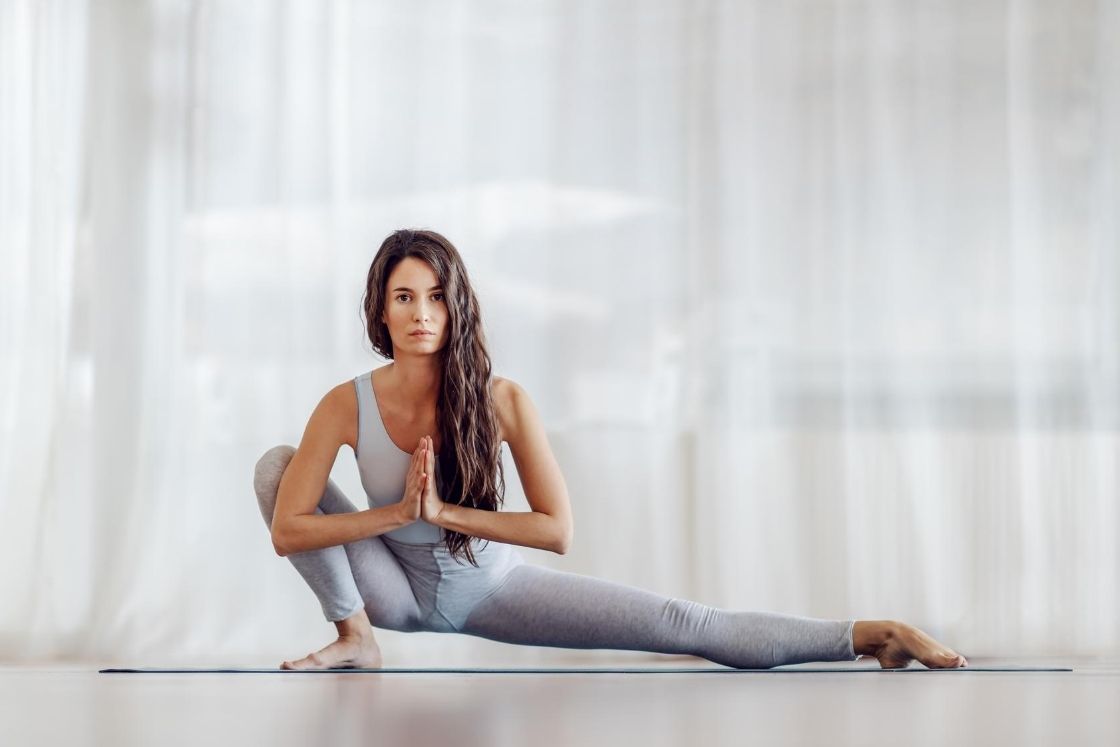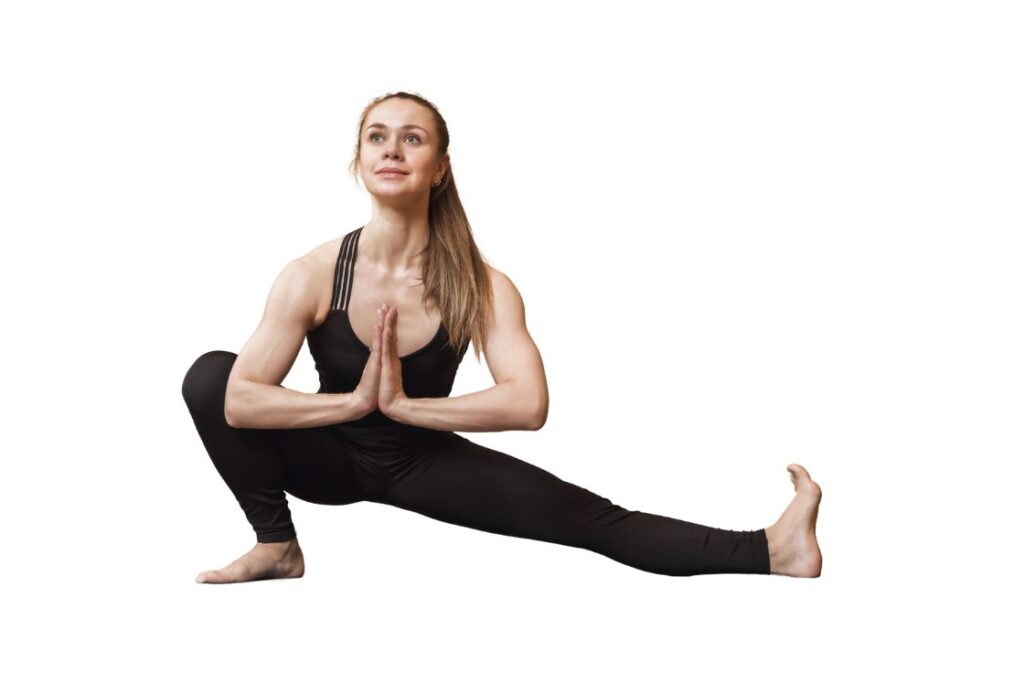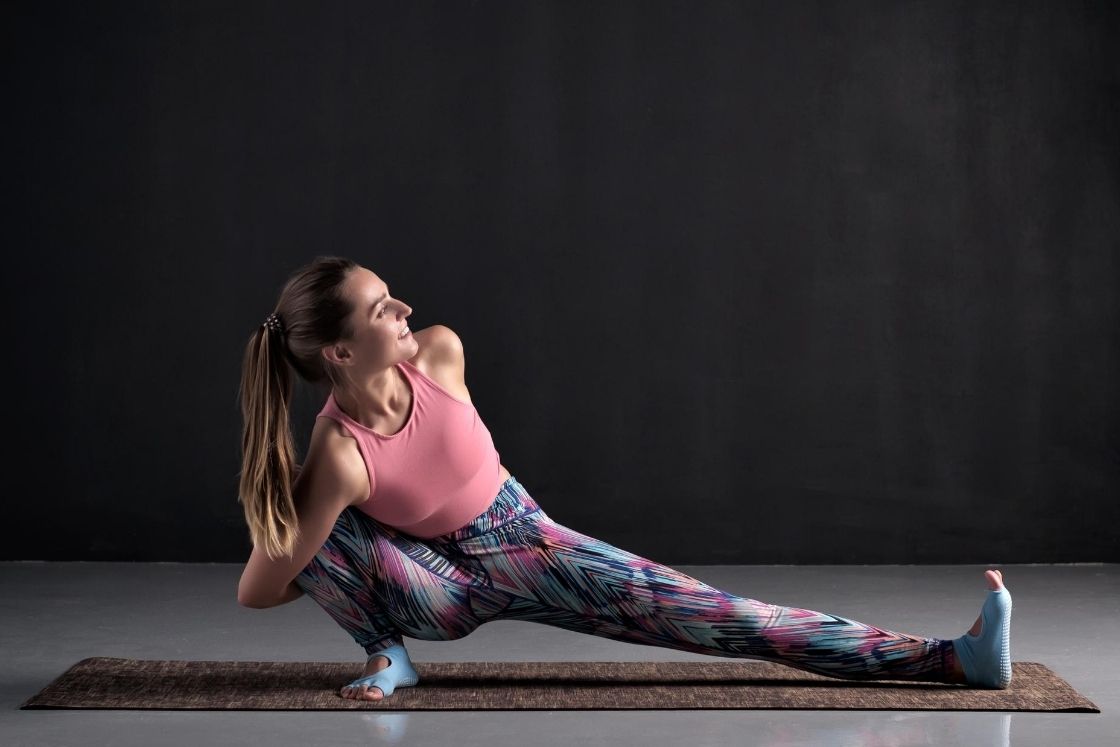[ad_1]

| Sanskrit Pronunciation | Skandasana (SKAHN-dahs-uh-nuh) |
| Meaning | Skanda = Warrior / Asana = Pose |
| Pose Type | Side Lunge, Hip Opener |
| Pose Level | Intermediate to Advanced |
| Anatomy | Hips, glutes, hamstrings, quadriceps, knees, ankles |
| Other Names | Side Lunge Pose, Warrior’s Lunge, Skanda Pose |
Skandasana, also known as the Side Lunge Pose, is a dynamic yoga posture that significantly enhances lower body flexibility, strength, and mobility. Targeting the hips, glutes, hamstrings, and quadriceps, this pose is a key component of any hip-opening sequence. Whether integrated into a yoga flow or practiced independently, Skandasana provides a deep stretch while challenging balance and stability, making it both physically rewarding and mentally engaging.
Incorporating Skandasana into your routine builds lower body strength and improves overall stability and alignment. This dynamic pose promotes mindful movement, boosting body awareness and coordination. As you shift your weight from one leg to the other, Skandasana not only stretches and activates tight muscles but also tones them, enhancing flexibility and resilience in daily activities.
Meaning
In Skandasana, the term “Skanda” refers to a warrior‘s position during an attack, and “asana” means “pose.” This pose is dedicated to Kartikeya, the elder son of Lord Shiva and the god of war. The side lunge position of Skandasana resembles a battle-ready stance, evoking the image of a warrior preparing for combat. As such, the pose is also known as the “pose of the war god,” reflecting its strong, assertive stance and its association with martial strength and readiness.
Mythology
According to the epic poem Kumarsambhava by Kalidasa, the demon Taraka was causing great disturbance among the gods. He had received a boon that he could only be killed by the son of Lord Shiva. To address this, Goddess Parvati approached Shiva, who was deep in meditation. To disrupt Shiva’s meditation, Kama (the god of love) shot an arrow of desire at him, which resulted in Kama being reduced to ashes when Shiva opened his third eye.
To reconcile with Shiva, Parvati embraced asceticism and religious discipline, ultimately marrying him. Eventually, their son Kartikeya (Skanda) was born. Upon reaching manhood, Kartikeya fulfilled the prophecy by defeating and destroying the demon Taraka.
Skandasana(Side Lunge Pose) practice guide
Skandasana offers a dynamic stretch and strength-building opportunity for the lower body. Here’s a guide on how to safely practice Skandasana, including preparatory poses, steps, tips, precautions, contraindications, follow-up poses, and variations.
Preparatory pose
How to do skandasana(steps)

- Stand with your feet wide apart, about three to four feet, and slightly turn your toes outwards.
- Shift your weight onto your right foot, bending your right knee while keeping your left leg straight and the toes pointing upwards.
- Lower your hips down and back, creating a deep lunge with your right leg, and keep your left leg extended.
- Place your hands on the floor in front of you for balance or use yoga blocks. Alternatively, bring your hands to a prayer position (Anjali Mudra) at your chest.
- Engage your core muscles to maintain stability and keep your torso upright with relaxed shoulders.
- Hold the pose for a few breaths, focusing on the stretch in your inner thighs and groin while maintaining steady breathing.
- Slowly return to the starting position and repeat the same steps on the opposite side.
- After practicing on both sides, return to a standing position with your feet together, taking a moment to notice the effects of the pose.
Beginners tips
- Place yoga blocks under your hands for support if you find it challenging to reach the floor, helping with balance and alignment.
- Ensure your bent knee is directly above your ankle and keep your feet hip-width apart with toes slightly turned outwards.
- Actively engage your core muscles to help stabilize your torso and maintain balance throughout the pose.
Precautions
- Avoid letting your bent knee extend beyond your toes to prevent strain on the knee joint
- Keep your back straight and chest lifted to avoid collapsing or rounding your spine.
- Ensure your weight is evenly distributed to prevent overloading one side and to maintain balance.
- Don’t force yourself into a deep lunge if you feel discomfort; work within your range of motion and use props if needed.
- Keep the extended leg engaged and the foot flexed to protect the hamstring and maintain alignment.
Contraindications
- Avoid the pose if you have recent or chronic knee injuries, as the deep lunge can strain the knee joint.
- Refrain from practicing if you have hip injuries or conditions that limit hip flexibility, as it may exacerbate discomfort.
- Skip the pose if you have lower back issues or herniated discs, as the position may place undue stress on the lower back.
- Avoid if you are pregnant or have any conditions that affect balance and stability, as the pose can be challenging and may affect your center of gravity.
Follow up poses
Variations
In the series of lunge pose, poses like Equestrian Pose, Low Lunge Pose and High Lunge Pose can be practiced.
Side lunge variations consist of different position of arms and upper trunk that can be practiced in following manner:
1. Utthita baddha parsva upvesasana (Bound side lunge stretch pose)

In this variation of side lunge pose, arms are wrapped around the bent leg so it bounds legs and deepens the opposite leg stretch. To do this:
- From the accomplished side lunge pose (described above), clasp your left wrist or simply your fingers with your right hand while wrapping your right leg’s shin bone. Keep your left foot pointing upwards and your gaze directed to the left.
2. Standing side lunge with forward bend
For this variation, after reaching the final position of the side lunge pose, straighten your trunk and then bend forward from your waist. In this position, your hands can rest on your legs or on the floor.
Props and modifications
- One can put a folded blanket under the heel to provide the necessary support to the posture.
- To deepen the stretching practitioners can balance the pose on the balls of the foot; as if unable to reach there with the sole.
- Practitioners can also place a block under their seats to avoid falling due to disbalance.
Skandasana benefits
Skandasana has many benefits for your yoga practice. It stretches your hips and legs, making them more flexible. This pose also strengthens your lower body muscles, helps you balance better, and improves your core strength. Practicing Skandasana can lead to better movement, stability, and overall strength.
- Enhances Lower Body Flexibility: Skandasana deeply stretches the hips, hamstrings, and groin. This increased flexibility in these areas helps improve overall mobility, making everyday movements like squatting and bending easier and more fluid.
- Strengthens Leg Muscles: Holding the side lunge position engages and strengthens the quadriceps, glutes, and hamstrings. This increased strength helps support better posture and stability in various activities, reducing the risk of injury.
- Improves Balance and Stability: Balancing in Skandasana challenges your core and stabilizing muscles. Enhanced balance and stability are crucial for activities that require coordination and precision, and they contribute to better overall body control.
- Increases Hip Mobility: The pose opens and stretches the hip joint, which can alleviate tightness and discomfort in the hips. Improved hip mobility supports better alignment and reduces the risk of injuries related to restricted movement.
- Stimulates Circulation: The dynamic nature of Skandasana helps stimulate blood flow to the lower body. Improved circulation supports better muscle recovery and overall cardiovascular health.
- Enhances Core Strength: Engaging the core muscles to maintain balance and stability in Skandasana strengthens the abdominal muscles. A strong core supports better posture, reduces back strain, and improves overall functional strength.
- Improves Joint Alignment: Skandasana helps to align the knee and ankle joints properly when done with correct form. Proper alignment reduces the risk of joint pain and discomfort, especially for individuals with previous injuries.
- Balances Sacral and Root Chakras: Skandasana influences the Sacral and Root Chakra, which are associated with feelings of security, stability, and pleasure. Balancing these chakras through the physical practice of the pose can enhance your sense of grounding and well-being.
Conclusion
Skandasana, or Side Lunge Pose, is a valuable addition to any yoga practice, providing significant benefits for both the body and mind. By targeting the hips, glutes, hamstrings, and quadriceps, this pose enhances lower body flexibility, strengthens core muscles, and supports joint health. Its dynamic nature improves balance and stability while promoting mindful movement and body awareness.
Regular practice of Skandasana can lead to increased flexibility, reduced stress, and better respiratory function. Additionally, it opens the hip joints and balances key energy centers, contributing to overall physical and mental well-being. Integrating Skandasana into your routine can help develop a more flexible, strong, and grounded body, while fostering a calm and focused mind.
Skandasana FAQs
Hold Skandasana for about 20-30 seconds on each side, or longer if comfortable. Focus on maintaining balance and a steady breath throughout the pose.
Use yoga blocks under your hands for support to maintain balance and alignment.
Yes, but beginners should use props and focus on alignment and balance. Gradually work into the pose as flexibility and strength improve.
Yes, it stretches the inner thighs, hamstrings, and hips, which improves overall flexibility.
Avoid letting your bent knee extend beyond your toes, rounding your back, or placing excessive weight on one side.
It is generally not recommended during pregnancy due to balance challenges. Consult with a healthcare provider for suitable modifications.
Incorporate Skandasana into your routine 2-3 times a week to enhance flexibility, strength, and stability.
In Skandasana, the heel of the bent leg is typically kept down on the floor to ensure stability and deepen the stretch. However, for a more advanced variation, you can lift the heel slightly or balance on the ball of the foot to increase the stretch.
[ad_2]
Source link










